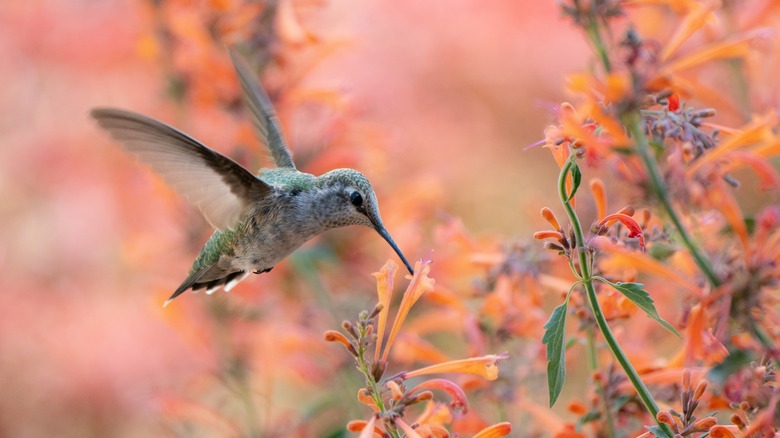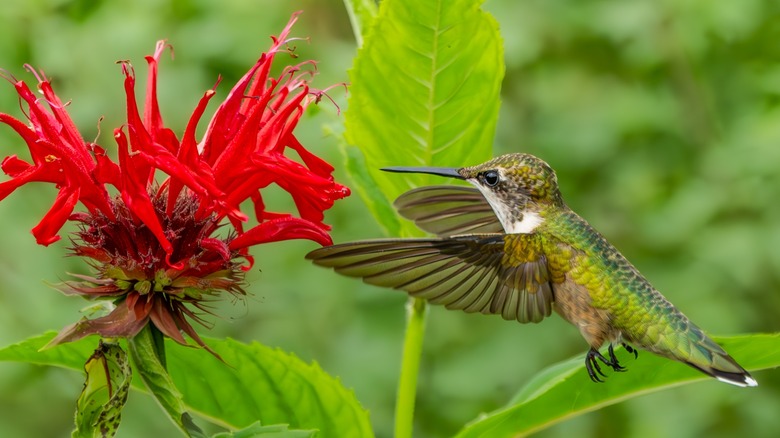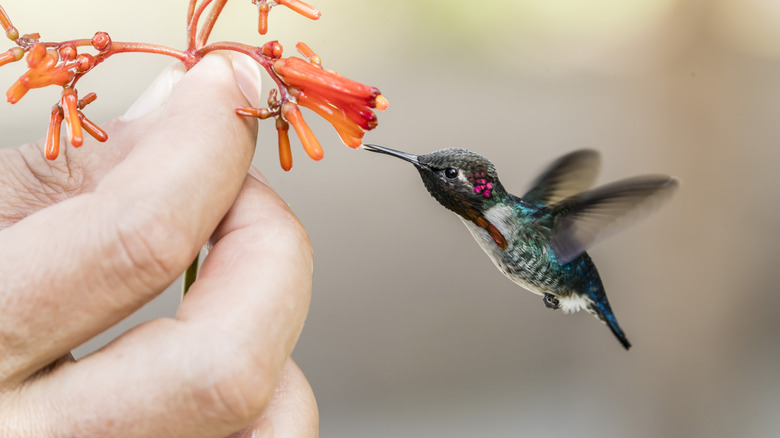Plant These Hummingbird Mint Companions To Attract More Feathered Friends
Attracting hummingbirds to your garden is more than just a lovely sight. Hummingbirds are the primary pollinators for a variety of native plants, sipping nectar from flower to flower with pollen sticking to their feathers and bill. Plus, they'll help keep your insect population under control. As aerial hunters, they also catch small insects in the air and snatch food from spiderwebs to get the protein their little bodies need.
To attract hummingbirds to your garden, you'll need to be intentional with brightly colored plants in reds, oranges, and yellows. While they're known for their excellent vision, hummingbirds have a poor sense of smell. You should also ensure to choose specific flower shapes from which their long and narrow beaks have adapted to reach the nectar inside.
As you make your yard hummingbird-friendly, choose plants native to your area. Hummingbird mint (Agastache), aka giant hyssop, is a mainstay for attracting more of these tiny, feathered friends to your garden. They're drought-tolerant, with plenty of nectar inside their tubular flowers to feed your local pollinators. However, like many mint (Lamiaceae) varieties, it can spread and take over the areas of other plants if you're not careful. To prevent this, try companion planting—or intentionally planting flowers that need similar conditions and will help each other grow instead of competing. Native flowers adapted for pollination by hummingbirds, like bee balm, cardinal flower, and coral honeysuckle, are all sustainable choices. Not only will your local birds love these plants, but your hummingbird mint will thrive alongside them.
Best native plant companions for hummingbird mint
How do you know which companion to hummingbird mint is best for your yard and the pollinators that flock to it? That depends on a few factors, like where you live and what you want to achieve with your garden. Plants that enjoy garden spaces with plenty of sun and hold their own through tough winters make good partners for hummingbird mint. With many varieties native to the U.S., yarrow (Achillea millefolium) is a hardy plant that grows well alongside the mint plant. Alternatively, try planting firebush (Hamelia patens) nearby. Not only will hummingbirds love its vibrant blooms, but it's a tough shrub that can handle cold winters and grows larger with every summer. Be careful planting it if you live in a warmer climate; in Florida, firebush is known to spread rapidly.
Bee balm is another versatile plant companion. It survives in various growing conditions in USDA zones 4 to 9. While hummingbirds and other pollinators love most varieties of bee balm, Scarlet Bee Balm (Monarda didyma) and Spotted Bee Balm (Monarda punctata) stand out as particular favorites. The cardinal flower (Lobelia cardinalis) is also a popular option for gardeners in the eastern U.S. to attract hummingbirds to their gardens. It grows well with hummingbird mint, as both need plenty of moisture and a balanced amount of direct sunlight and shade. Coral honeysuckle (Lonicera sempervirens), too, thrives in the same conditions as both of these pollinator-friendly plants and is a good alternative to more invasive honeysuckle varieties.
Plants to avoid planting with hummingbird mint
Despite being native to the U.S., Hummingbird mint can be aggressive if left unchecked and may quickly spread into an incompatible plant's space. Like all varieties within the mint family, you'll want to avoid placing herbs like lavender, rosemary, and thyme next to it. Try not to plant other types of mint nearby as well, as they might compete for the same nutrients and overcrowd each other. However, hummingbird mint can thrive in containers with plenty of drainage and access to sunlight. If you want to introduce it to an area near an incompatible plant, using a pot or a planter might be a good solution.
Additionally, hummingbird mint prefers well-draining soil and is at risk of developing root rot when overwatered. Save plants that prefer bog or high-moisture conditions, like marsh marigolds or flag irises, for a different area in your garden. Powdery mildew is another common disease for hummingbird mint. To prevent its spread, avoid plants susceptible to powdery mildew, like lilacs, snapdragons, and wisteria.
If your goal is to bring hummingbirds to your garden, stick to flowers with tubular shapes and plenty of nectar. Hummingbirds generally avoid plants with different shapes or lower nectar levels, like tulips, roses, or sunflowers. Save them for a different area in your garden. Pesticides can also harm hummingbirds and reduce their food sources. It's best to avoid their use on plants where you want to attract pollinators.
That being said, some invasive plant species may be hummingbird-friendly but can damage your yard in the long term. Amur honeysuckle (Lonicera maackii) and Japanese honeysuckle (Lonicera japonica) can easily take over a garden and drain nutrients from other flowers. While both are beautiful, it's safest to stick with coral honeysuckle.


